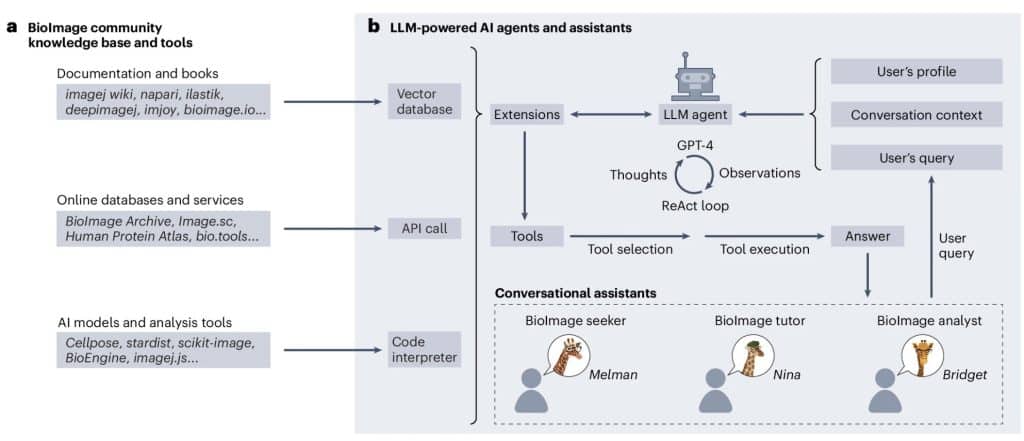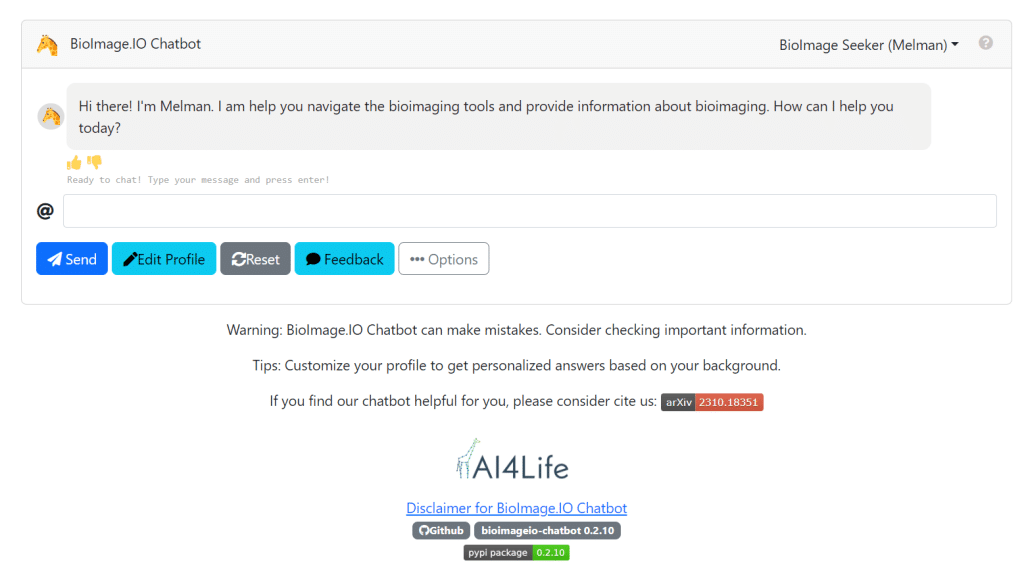BioImage.IO Chatbot: Ready to use and discover!
Posted by Caterina Fuster-Barceló, on 21 August 2024
We are delighted to announce the publication of the BioImage.IO Chatbot in Nature Methods this August and its immediate availability for the bioimaging community. This milestone signifies academic recognition and marks the chatbot’s readiness for everyday use in streamlining complex bioimage analysis tasks.
Broadening Access to Advanced Bioimage Analysis
The BioImage.IO Chatbot, equipped with state-of-the-art AI technologies like Large Language Models (LLMs) and Retrieval Augmented Generation (RAG), democratizes access to sophisticated bioimage analysis. It is designed to be intuitively used by researchers of all skill levels, significantly reducing the complexity and technical barriers traditionally associated with advanced bioimaging techniques.

How to Utilize the BioImage.IO Chatbot
- Easy Interaction: Simply type a query or describe your analysis need, and the chatbot will guide you through accessing models, performing tasks, or retrieving information.
- Direct Model Execution: Execute bioimage analysis models (CellPose) directly through the chatbot interface, with no coding required. Upload your data, choose a model, and let the chatbot handle the analysis.
- Personalization and Extensions: Tailor the chatbot to your research requirements by creating and integrating custom extensions.
Step-by-Step Guide to Getting Started:
- Visit the Platform: Go to https://bioimage.io/chat as it is hosted by the BioImage Model Zoo Community.
- Engage with the Chatbot: Input questions about bioimage analysis, specific commands to run models, and about tools that are connected to the chatbot such as deepImageJ, ImJoy, the BioImage Archive and others.
- Follow the Instructions or View Results: The chatbot will provide detailed instructions, link you to resources, or display the analysis results directly in your session.

For a more detailed explanation on how to use it, please visit our documentation site!
Why you should try it?
- Accelerate Your Research: Streamline complex bioimage analysis processes, saving time and increasing efficiency.
- Access Cutting-Edge Tools: Instantly tap into a vast repository of advanced tools and comprehensive methodologies.
- Improve Research Reliability: Enhance the reproducibility of your results with standardized and well-documented procedures.
How You Can Participate
The BioImage.IO Chatbot is not just a tool but a growing community, and there are several ways you can get involved to help it evolve:
- Use the Tool: Simply start by using the chatbot. Your interaction provides valuable feedback that helps improve its functionality and user experience. Of course, give us feedback when using it!
- Develop New Extensions: Enhance the chatbot’s capabilities by creating and adding new extensions that cater to specific needs in the bioimage analysis community. Read more about the extensions in our docs!
- Link Your Documentation: If you have a tool or resource that could benefit the community, link your documentation to our platform. Contribute by making a Pull Request (PR) to our GitHub repository as detailed in our contribution guidelines in our docs.
- Enhance Documentation: Help us make information more accessible by improving your documentation—make it clear, digestible, and structured in a way that the chatbot can easily interpret and utilize.
- Cite Our Work: If you find the BioImage.IO Chatbot useful in your research, please cite our publication. This not only supports our work but also aids in further developing and refining the chatbot for future advancements.
A Collaborative Achievement
The BioImage.IO Chatbot project exemplifies a remarkable collaborative effort among top research institutions. Developed through the partnership of the AICell Lab at KTH Royal Institute of Technology, the Department of Intelligent Systems at KTH, Ericsson Inc., BSEL from Universidad Carlos III de Madrid, and Instituto de Investigación Sanitaria Gregorio Marañón, this tool stands as a testament to international cooperation. The leading contributors—Wanlu Lei, Caterina Fuster-Barceló, Gabriel Reder, Arrate Muñoz-Barrutia, and Wei Ouyang—brought together their diverse expertise to push the boundaries of AI-driven bioimaging.
Acknowledgments
We extend our deepest gratitude to all the authors and contributors listed in the knowledge base manifest, especially the original authors of the materials integrated into our extensions. Their invaluable work has significantly enhanced the capabilities of the BioImage.IO Chatbot, providing users with high-quality information and tools. We also thank the open-source community for their ongoing support and innovation, which continuously drives the development and improvement of the BioImage.IO platform.
Join us in exploring the capabilities of the BioImage.IO Chatbot and see how it can transform your approach to bioimage analysis. We’re excited to support the bioimaging community with this powerful tool, making advanced analysis techniques accessible to everyone.
Read the full article here: Nature Methods, August 2024
AI4Life has received funding from the European Union’s Horizon Europe research and innovation programme under grant agreement number 101057970. Views and opinions expressed are, however, those of the author(s) only and do not necessarily reflect those of the European Union or the European Research Council Executive Agency. Neither the European Union nor the granting authority can be held responsible for them.


 (No Ratings Yet)
(No Ratings Yet)
